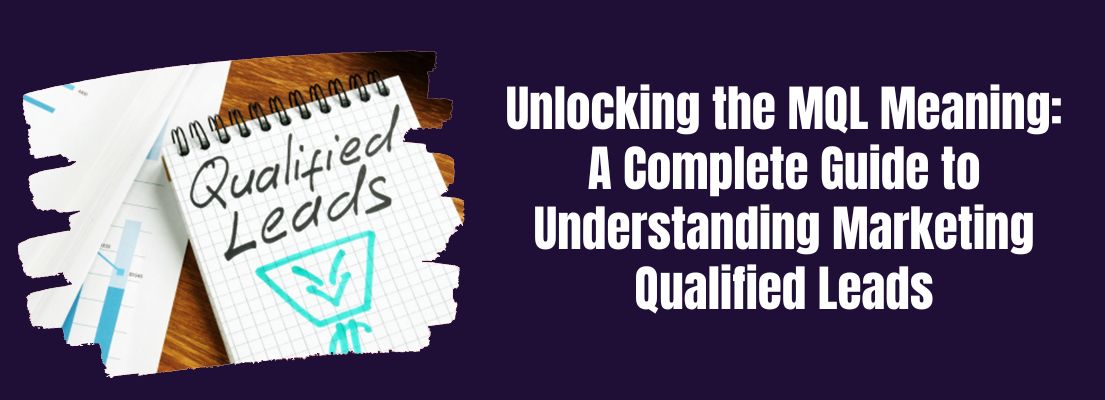Imagine you’re at a bustling trade show, surrounded by potential customers. Everyone seems interested, but who is ready to buy? In the digital marketing world, distinguishing between casual browsers and serious buyers is crucial, and it’s where the concept of Marketing Qualified Leads (MQLs) comes into play. In this ever-evolving landscape, understanding the difference between someone just looking around and a lead ready to make a purchase can be the game-changer your business needs.
In this comprehensive guide, we’ll dive into the heart of what makes an MQL. We’ll unravel the mystery behind their behaviors, how they fit snugly into your sales funnel, and most importantly, how to nurture and transform these leads into loyal customers. Ready to unlock the secrets of MQLs and revolutionize your marketing strategy?
Let’s embark on this journey together and explore the pivotal role MQLs play in bridging the gap between curiosity and conversion.
Key Takeaways
- MQLs are leads identified as having the highest potential for conversion based on their behaviors, demographics, and interactions with a company’s online content.
- Lead scoring and customer feedback help to identify promising MQLs ready to transition to SQLs.
- Collaboration between sales & marketing teams is essential for optimizing lead generation & conversion through shared goals & criteria, communication/feedback loops, analytics/data usage, and follow-up strategies.
Decoding MQL: The Essentials of Marketing Qualified Leads
Prospects who have demonstrated interest in a product or service and require additional nurturing before being forwarded to the sales team are known as Marketing Qualified Leads. The distinction between MQLs and sales-qualified leads lies in the level of intent to purchase. MQLs are inquisitive, while SQLs are strongly motivated to complete a transaction.
This distinction is essential, as it enables sales reps to:
- Optimize their time
- Target more qualified prospects for impactful conversations
- Provide valuable insights into the effectiveness of the sales process
- Determine the likelihood of leads converting.

The marketing team is responsible for:
- Identifying MQLs based on the prospective customer’s behavior, such as taking some form of active contact action to explore what is available
- Collaborating with the sales team to prevent prospects from dropping off the journey, cut down on marketing budget waste, and enhance ROI
- Prioritizing their nurturing efforts and progressing more leads through the sales funnel
Identifying MQLs enables marketers to prioritize their nurturing efforts and progress more leads through the sales funnel.
Identifying a Marketing Qualified Lead
Identifying MQLs necessitates businesses to scrutinize customer behavior, marketing data, and historical buyer journeys to determine the leads with the highest conversion probability. A Marketing Qualified Lead (MQL) is a lead that has satisfied predetermined criteria regarding demographics, online behavior, and content engagement. Identifying MQLs is the duty of the marketing team. The lead’s value is determined by its worth before passing it on to an SDR.
The process involves observing the visitor’s behavior on the website and how they interact with the company online. Demographic fit, such as age, gender, location, and job title, determines if the lead is an appropriate match for the company’s offerings. Engagement with marketing content, such as website behavior, content engagement, and overall interaction with the brand’s marketing initiatives, indicates a potential MQL.
Key Characteristics of MQLs
MQLs are defined by their evident interest in a product or service, a result of marketing initiatives. They have shown a degree of engagement or interest in the company’s products or services. Demographic fit is an essential component in assessing whether a lead is a suitable MQL. Factors such as:
- Age
- Gender
- Location
- Job title
Provide valuable insights into the likelihood of a prospective customer to convert.
A demonstrated interest in the company’s offerings is a key indicator of an MQL, reflecting the lead’s active engagement with the company’s products or services. It can be gauged through various criteria, including website visits, content downloads, and other interactions with the company’s offerings. Such behavioral characteristics are crucial for determining whether a lead should be classified as an MQL or SQL.
How MQLs Fit into the Sales Funnel
MQLs hold a significant place in the sales funnel. They demand further nurturing and involvement before they can be considered sales-ready leads (SQLs). Lead scoring assigns numerical values to each lead generated for the business, typically point values, based on their engagement and demographic information. This process assists in identifying promising leads, allowing for a more targeted response and ultimately resulting in a higher conversion rate.
The BANT system (budget, authority, needs, and timeline) is a framework for evaluating whether a lead is a viable customer and can be employed to assess if a lead is a suitable customer by analyzing these factors. Businesses can determine when an MQL is ready to transition to SQL based on their online behaviors and engagement with marketing campaigns by implementing a lead-scoring system.
The Lifecycle of a Marketing Qualified Lead
The typical MQL lifecycle comprises the following stages: Subscriber, Lead, Marketing Qualified Lead (MQL), Sales Qualified Lead (SQL), Opportunity, and Customer. During this lifecycle, leads are assessed, sorted, qualified, and advanced through the sales funnel. The indications that an MQL is ready to transition to an SQL can fluctuate depending on the buyer’s actions, such as requesting to schedule a call, expressing curiosity about specific product details, and demonstrating a willingness to purchase but still requiring additional information.
From initial engagement to repeat engagers, MQLs progress by consuming marketing content and interacting with the company’s offerings. Demographic insights can help refine MQL identification by providing a clearer picture of the ideal customer profile and their likelihood to convert. Communication and feedback loops between sales and marketing teams are essential for refining the MQL identification process and improving lead quality.
From First-Time Visitor to Repeat Engagement
The journey of a first-time visitor evolving into a repeat engager generally moves through stages like:
- Awareness: when a visitor initially discovers the company’s offerings
- Engagement: when the visitor interacts with these offerings
- Return visits: when the visitor returns to the company’s website or other offerings
- Repeat engagement: when the visitor continues to interact with the company’s offerings
Content that is based on research and provides informational value is suitable for first-time visitors to a website who are MQLs. For MQLs who have already visited the site and are ready to become an SQL, content related to a particular action at the bottom of the funnel is recommended, such as “Things to Know Before Acquiring CRM Software”. A potential customer should view relevant product or service pages three or four times before being classified as an SQL.
Nurturing MQLs to Advance the Buyer’s Journey
The nurturing of MQLs entails providing pertinent content, using personalized messaging, and carrying out timely follow-ups to advance them through the buyer’s journey. Segmentation, personalized outreach, and personalized content are effective for advancing MQLs. The timing of follow-ups can significantly affect the progression of MQLs in the buyer journey, with studies demonstrating that delaying the initial follow-up attempt can lead to a decrease in conversion rates.
It is important to be persistent yet respectful in follow-ups to maintain the lead’s interest and respect their time. Additionally, prompt and timely responses to MQLs can significantly contribute to advancing them through the buyer journey. Utilizing automated email sequences, phone calls, and other forms of communication can help ensure timely follow-ups.
Transitioning MQLs to SQLs: When Is the Right Time?
An MQL should transition to an SQL and be forwarded to the sales team when the lead presents a strong inclination to buy and meets the criteria set by both the sales and marketing teams. When they have completed the research stage and their online behavior demonstrates that they are prepared to proceed to the next step, an MQL is ready to be converted to an SQL.
Implementing a lead scoring system can be an effective approach to decide when an MQL is ready to transition to an SQL based on their online behaviors and engagement with marketing campaigns. Observing the visitor’s behavior on the website and how they interact with the company online can provide insights into a lead’s readiness to become an SQL.
Collaboration Between Sales and Marketing Teams

Setting a common definition for MQLs ensures that the sales and marketing departments align in their efforts to identify, nurture, and convert MQLs into SQLs. Defining shared goals and criteria for MQLs between sales and marketing teams includes:
- Identifying and recording the main characteristics of an MQL
- Using criteria to assess the likelihood of a lead becoming a paying customer
- Enhancing collaboration and focus between the two teams
- Agreeing on definitions and indicators for MQLs and SQLs
- Aligning goals of attracting customers and generating revenue.
The exchange of communication and feedback between sales and marketing teams aids in refining the process of MQL identification and enhancing lead quality. Some key steps to optimize the MQL to SQL conversion process include:
- Analyzing customer feedback
- Tracking metrics
- Making data-driven decisions
- Evaluating the success of marketing campaigns and lead-generation efforts
- Allowing for data-driven decision-making and continuous improvement.
These steps are essential for improving the overall effectiveness of marketing assets and sales efforts.
Defining Shared Goals and Criteria
Establishing shared objectives and criteria ensures that both teams work in alignment to identify, nurture, and transform MQLs into SQLs. Shared goals and criteria for MQLs between sales and marketing teams include:
- Identifying and recording the main characteristics of an MQL
- Using criteria to assess the likelihood of a lead becoming a paying customer
- Enhancing collaboration and focus between the two teams
- Agreeing on definitions and indicators for MQLs and SQLs
- Aligning goals of attracting customers and generating revenue
The benefits of establishing a unified definition of MQLs for sales and marketing alignment include:
- Providing both teams with a clear understanding of what constitutes a qualified lead
- Helping salespeople focus on leads with a higher likelihood of conversion
- Allowing marketing to better align their efforts with revenue generation.
Moreover, a unified definition of MQLs encourages better collaboration and communication between sales and marketing teams as they work together to nurture and convert leads.
Communication and Feedback Loops
The MQL identification process can be significantly enhanced through communication and feedback loops. They enable marketing teams to:
- Gather and analyze feedback from various sources like customer responses and lead generation efforts
- Refine lead generation strategies and enhance the quality of MQLs
- Continually refine and optimize their MQL identification process based on the insights gained from the feedback
The sales team’s feedback provides beneficial insight into the caliber of MQLs and assists the marketing team in comprehending which leads have a higher probability of becoming customers. This feedback loop facilitates ongoing optimization and harmony in defining MQLs that are compatible with the plans and objectives of the sales team.
Measuring MQL Success and Adjustments
Assessing MQL success entails monitoring vital metrics like conversion rates and lead quality and making course corrections based on insights and feedback. To calculate the conversion rate of MQLs to sales, one should divide the number of sales by the number of MQLs and multiply the result by 100. CRM software can assist in assessing the influence of MQLs on sales by furnishing real-time sales reports and analytics, enabling businesses to monitor a prospect’s interaction with their website and emails and evaluate the efficacy of marketing campaigns.
Data and metrics can be leveraged to optimize MQL success by:
- Tracking key metrics such as conversion rates and lead quality
- Utilizing this data to pinpoint areas of improvement and make adjustments to the MQL process
- Employing customer feedback to refine MQL identification and devise more effective strategies for engaging MQLs
Enhancing MQL Quality Through Analytics and Data
Improving MQL quality through analytics and data requires utilizing:
- Lead scoring: assigns numerical values to leads based on their engagement and demographic information, helping prioritize and improve conversion rates.
- Demographic insights: help refine MQL identification by providing a clearer picture of the ideal customer profile and their likelihood to convert.
- Customer feedback: helps fine-tune the identification and nurturing process.
Analyzing customer feedback helps identify trends and areas for improvement in the MQL development process. Businesses can refine their criteria for identifying MQLs and enhance their interaction tactics, enabling them to identify and nurture leads that are more likely to become customers by analyzing customer feedback.

Leveraging Lead Scoring for Better Qualification
Lead scoring is a process where each lead is assigned a numerical value derived from their data and behavior. When assessing leads, the following factors are taken into account:
- Customer data
- Buying interest and engagement
- Demographic information
- Activity and engagement
- Scoring criteria
Indeed, lead scoring can potentially improve conversion rates by assigning scores to leads based on their sales readiness. It facilitates collaboration between marketing and sales teams, resulting in higher conversion rates and faster deal closures.
Businesses can determine when an MQL is ready to transition to SQL based on their online behaviors and engagement with marketing campaigns by implementing a lead-scoring system. It enables marketing and sales teams to focus their efforts on prospects with a greater chance of conversion, optimizing efficiency and boosting the chances of generating high-quality MQLs.
Using Demographic Insights to Refine MQL Identification
Demographic insights are fundamental in refining the identification of MQLs. By analyzing:
- Job title
- Industry
- Company size
- Location
Businesses can accurately pinpoint potential MQLs. This data provides insight into the target audience and enables the development of marketing strategies that effectively engage and nurture these leads.
Utilizing demographic insights can assist in refining MQL identification by analyzing the characteristics of successful customers and recognizing common demographic details, such as industry, company size, job roles, and purchasing habits among those leads. This information can then be employed to develop more precise and customized marketing campaigns, refine lead-scoring criteria, and enhance the overall MQL identification process.
Analyzing Customer Feedback for MQL Development
Customer feedback is vital to MQL development as it provides invaluable data about customer needs, preferences, and expectations. Through analyzing customer feedback, businesses can refine their criteria for identifying MQLs and enhance their interaction tactics, enabling them to identify and nurture leads that are more likely to become customers.
Several tools that may be utilized to acquire demographic insights for MQL identification include audience insights tools, customer analytics tools, and lead intelligence forms. Businesses can optimize lead generation strategies and improve the quality of MQLs by incorporating feedback loops into the MQL identification process.
Real-World Applications: Marketing Qualified Lead Actions

In the real world, MQL actions can take many forms, such as downloading whitepapers, attending webinars, or requesting product demos, all of which indicate a heightened interest in the company’s offerings. These actions help businesses understand the effectiveness of their marketing efforts and make data-driven decisions to improve lead quality and conversion rates.
Strategies that have proven successful in encouraging Marketing Qualified Leads (MQLs) to download content include:
- Defining MQL criteria
- Segmenting leads
- Creating customized content for different funnel stages
- Offering value
- Creating multiple omnichannel touchpoints
- Engaging with leads on social media
- Creating a lead-generation-focused website
Downloading Content and Other Criteria
MQLs commonly download diverse content like ebooks, guides, and trial software. It demonstrates their interest in a company’s products or services and offers valuable insights into their specific areas of interest. Downloading a whitepaper indicates interest from a potential lead, as it signifies that the lead is actively searching for information and is prepared to devote time to understanding more about a particular subject or solution.
Webinars and product demonstrations can also be effective tools in qualifying MQLs by exhibiting the product or service to potential leads and enabling them to perceive the value and advantages firsthand. It assists in identifying leads who have a substantial interest in the product or service and are more likely to make a purchase.
Follow-Up Strategies for Engaged Leads
Strategies for following up with engaged leads encompass personalized messaging, prompt communication, and targeted content to guide MQLs toward conversion. Defining a specialized team to interact with leads, gaining an understanding of their needs and goals, responding promptly, nurturing leads with relevant content, and utilizing a customer relationship management (CRM) platform are effective strategies for engaging marketing qualified leads.
It is generally recommended to follow up with engaged leads promptly, typically within 24-48 hours, to sustain their interest and progress them further along the sales funnel. Utilizing automated email sequences, phone calls, and other forms of communication can help ensure timely follow-ups.
Evaluating the Impact of MQL Actions on Sales
Assessing the impact of MQL actions on sales enables businesses to comprehend the effectiveness of their marketing initiatives and make data-driven decisions to enhance lead quality and conversion rates. CRM software can assist in assessing the influence of MQLs on sales by furnishing real-time sales reports and analytics, enabling businesses to monitor a prospect’s interaction with their website and emails and evaluate the efficacy of marketing campaigns.

Summary
In conclusion, understanding the intricacies of marketing qualified leads is essential for optimizing the sales funnel and ensuring businesses can effectively nurture and convert prospects into customers. Businesses can enhance the quality of MQLs, ultimately leading to increased revenue and growth by leveraging analytics and data, integrating lead scoring systems, and fostering strong collaboration between sales and marketing teams.
Recommended Reading: 5 Things You Need to Know About The B2B Marketing Funnel
Frequently Asked Questions
What is an MQL and SQL?
An MQL (Marketing Qualified Lead) is a person who has expressed interest in your products or solutions, while an SQL (Sales Qualified Lead) is someone who is further along the sales funnel and intends to buy. The difference between an MQL and an SQL is intent, so each lead type requires different brand messaging.
What is the MQL strategy?
MQL strategy involves identifying potential customers as having a higher likelihood of becoming paying customers through marketing activities such as website visits, content downloads, webinars, and other interactions with a brand.
What is an MQL score?
A Marketing Qualified Lead (MQL) score is a lead scoring threshold that defines when a prospect is ready to be passed from marketing to sales. It is the point value where a prospect is considered engaged enough and sales-ready. MQL scores measure interest and engagement, allowing marketers to create opportunities for leads to reach Sales.
What is the difference between a marketing-qualified lead (MQL) and a sales-qualified lead (SQL)?
A marketing qualified lead (MQL) is a prospect that has shown interest in a product or service but needs to be nurtured further, whereas a sales qualified lead (SQL) is ready for the next stage of the sales process.





